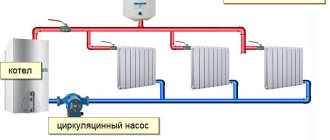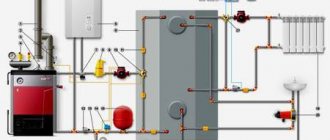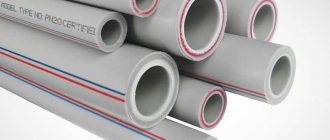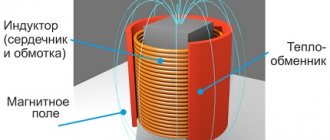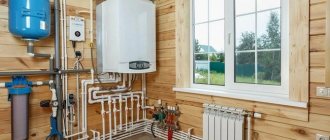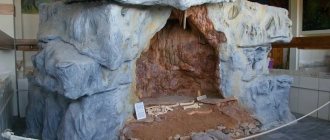The climate in the surrounding area is such that it is impossible to live in a private house without heating. If this issue does not affect apartment residents, because they keep warm with what they have, then rural residents have a huge choice! Everyone chooses the option that is more suitable for the owner.
In your own home, it is possible to arrange any of the suggested heating examples and combinations. To make the right choice, you should “arm yourself” with knowledge in this area; a photo of heating in a private house will help you figure it out.
See below for the types of heating systems for a private home.
Heating by stove
About 50 years ago, the method was widespread for large and medium-sized private houses. Moreover, it did not have any additions; the heat spread only from the hearth itself. Residents were forced to install 2 stoves in one house in order to feel a comfortable temperature throughout the house.
Now this option is rare, mainly in dachas, villages, or as an addition to the heating system. The main disadvantages are sudden temperature changes: if you heat it up it’s warm, the night goes by and it’s very cold again.
There is no way to adjust the temperature, the heat distribution is not uniform, it comes only from the heated walls of the structure, that is, it can be cold in another corner of the room.
Another point is constant attachment to the process, maintaining the fireplace, cleaning, and restarting the kindling in the morning. Because of these nuances, this option is rarely found as the main one.
"VIP HEATING" offer
specializes in the development of heating projects for residential buildings and is ready to help you in the design, installation and commissioning of heating systems. Our specialists are highly qualified - you can see for yourself the quality of the work performed. Over the years on the market, the company has managed to complete a number of projects for the installation of heating systems of various types, and we make no secret of our results.
“VIP HEATING” is ready to offer you a number of advantages that you can appreciate by ordering a heating project from us:
- high-quality components supplied by our company offers only high-quality equipment from leading manufacturers of materials for heating systems;
- the qualifications of our employees allow them to work with both standard projects and non-standard solutions;
- streamlined actions help us guarantee high speed of work: from the delivery of equipment to the direct installation of the heating system;
- With us you can order both individual types of work and turnkey installation, which includes everything from the development of a heating project to installation and commissioning of the system;
- our specialists carry out work in accordance with modern standards, including GOST - so you will be confident in the safety and reliability of the heating system in your home;
- we provide a guarantee for the work performed: if you are not satisfied with something, you can contact us within 18 months, and we will correct all the shortcomings;
- prices for our work are available to a wide range of clients: we are ready to help everyone choose a heating option that suits them with cost and characteristics.
Rest assured: a heating project for a residential building from “VIP HEATING” is excellent quality at an attractive price. You can always contact us with questions related to our field, and we will provide you with advice.
Water heating
The optimal, widely known type in our time. The composition includes a water heating tank, pipeline, radiators - the process of circulation of coolant (water) occurs through them. The most labor-intensive stage in installation is the correct placement of the pipeline.
Advantages: cyclical, or constant work. The operation completely depends on the type of boiler, for example, in a solid fuel boiler there will be cycles, you need to add firewood or coal. For convenience, a heat accumulator is installed; its essence is to accumulate peak temperature heights. When combustion stops, it maintains the optimal temperature in the room.
Having a boiler of another type (gas, liquid fuel) there will be no problems with cycling. Having started its work, it maintains the temperature almost the same throughout the entire time. A pleasant thing is the improvement in this type of automation, due to which it can work for a long time without intervention.
Features of a water heating system and choice of circulation circuit
The OS, where the coolant circulates naturally, is as simple as possible. In such a circuit, water is heated in the boiler and, according to thermodynamic laws, flows upward along the riser. Having reached the radiator elements, the coolant releases part of the heat energy, and its temperature decreases. Under pressure, the heated, cooled water is released back into the boiler - and the cycle repeats.
High-quality pumping equipment for OS with forced circulation must meet the following criteria:
- energy saving;
- ease of operation;
- durability.
The power is determined by the size of the home that needs to be heated.
On a note!
For example, to heat 250 m², a circulation pump with an indicator of 3.5 m³/h and a pressure of 0.4 atm is required.
In addition, the choice of pump is influenced by calculations from the heating circuit design. This:
- pipeline system material used for installation;
- pipe diameter;
- total length of the system;
- number of heaters;
- type of coolant.
Selecting pumping equipment on your own can be difficult, so it is recommended to consult an expert.
When installing an OS with forced circulation of the coolant, it is not necessary to comply with the requirements for the slope of the pipes. Heat lines are installed in a straight line or with a slight slope relative to the drain. This will make it easier to release water before carrying out repairs or, for example, in a situation where the OS faces a long downtime.
Air type heating
The basis of such heating is a boiler; unlike water heating, it heats the air. Thus, the convector acts as a heat source. Air ducts are drawn from it, so heat penetrates into the room. To heat a small house of 2 rooms, the heat of a generator is sufficient, without any additional additions.
The downside is the inconsistent heat and dry air.
Stove heating
For quite a long period, stove heating was considered the most affordable and most efficient, and therefore was used in a large number of houses. However, such a system had one significant drawback - the heat emanating from the main source (stove) was distributed extremely unevenly throughout the rooms of the house. That is, the further the room is from the stove, the colder it was. In addition, even in the room where the stove was installed, the heat was distributed unevenly - it simply rose upward. Thus, despite active heating, the floor of the room always remained cold.
Stove heating
The most rational use of stove heating is exclusively for small houses with only 2-3 rooms. For a large house with complex architecture, it is more rational to choose a different room heating system.
Electric heating
The principle of the device is simple, but the cost is a little expensive. In this option, there is no labor-intensive work at all - purchase convectors, place them in the right places (under the windows or on the wall a little higher), connect them to electricity.
There are two types of such options - with and without a fan. There is an automatic temperature barrier, no maintenance required.
Disadvantages - air movements move dust at great speed, drying out the air.
Having considered all the available options, we can draw conclusions to determine which heating is better for a private home. It all depends on the desired result, target category, type of housing. Well-chosen, built-in wiring in your home will make it possible to organize uniform and fast heating of the entire house at the same time.
- Long-burning boilers: review of the best models of 2021 + instructions for beginners
Do-it-yourself potbelly stove: effective devices and features of operating a stove with maximum efficiency
Fire safety of public buildings
There are the following types of heating schemes:
- Coolant circulation.
- Layout of main pipes.
Basically, they install one strip of pipes, two pipes, or a beam system. Schemes for heating private houses are drawn up at the zero stages of work, for a more logical construction of the installation plan.
Homeowners who have purchased a country house often wonder how they can make home heating with their own hands? For such favorites of “their own skill,” there is an optimal average option; for a detailed description, see the section “do-it-yourself brick cauldron.”
Latest heating systems
An example of a fairly affordable and at the same time effective system, suitable for both a country house and an apartment, is an electric heated floor. By incurring relatively small expenses for the installation of such heating, you can provide your home with heat and not buy any boilers. There is only one drawback - the cost of electricity. But considering that modern underfloor heating is quite economical, and if you have a multi-tariff meter, this option may be acceptable.
For reference. When installing an electric heated floor, 2 types of heaters are used: a thin polymer film with applied carbon elements or a heating cable.
In southern regions with high solar activity, another modern heating system performs well. These are water-based solar collectors installed on the roof of buildings or other open areas. In them, with minimal losses, water is heated directly from the sun, after which it is supplied to the house. One problem is that collectors are absolutely useless at night, as well as in the northern regions.
Various solar systems that take heat from the ground, water and air and transfer it to a private home are installations that implement the most modern heating technologies. Consuming only 3-5 kW of electricity, these units are capable of “pumping” 5-10 times more heat from outside, hence the name – heat pumps. Then, using this thermal energy, you can heat the coolant or air, at your discretion.
An example of an air heat pump is a conventional air conditioner; their operating principle is the same. Only a solar system heats a country house equally well in winter and cools it in summer.
Photo of heating a private house
Heating water pipes from freezing: installation methods and rules for installing heating elementsChimneys for gas boilers: main types and step-by-step installation instructions
- Solar collector: DIY production and operating features
Heating installation
Before starting work, you need to decide on the location where the boiler will be located. If its power is not higher than 60 kW, then it can be placed in the kitchen space.
In other cases, you need to prepare a separate room, which should be well ventilated. It is also necessary to make a chimney through which combustion products will escape.
Let's look at the photo of the heating of the house and see how the boiler connection system is arranged.

